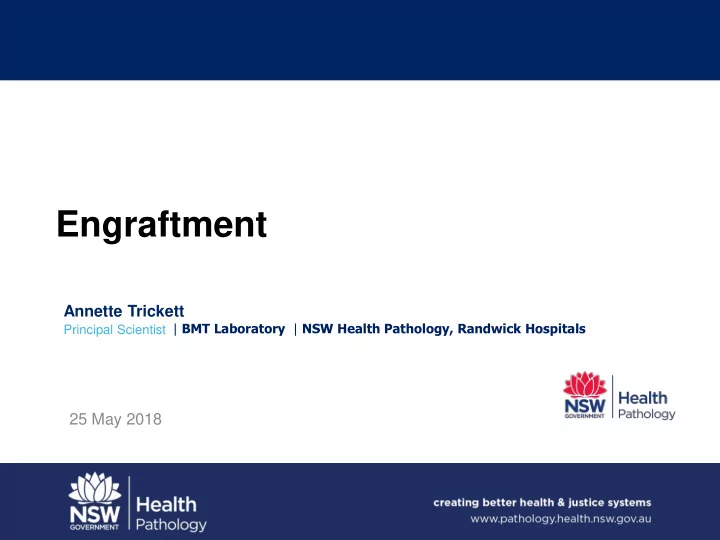

Engraftment Annette Trickett Principal Scientist | BMT Laboratory | NSW Health Pathology, Randwick Hospitals 25 May 2018
Scope Aim: • Provide a better understanding of the engraftment timeline and impacting factors Objectives: • Define haematological reconstitution • What can affect engraftment? • Recovery of immune function • Failure of engraftment and rescue strategies
Haematological reconstitution • Recovery of neutrophil and platelet counts after the nadir induced by conditioning therapy • Sustained absolute neutrophil count (ANC) ≥ 0.5 x 10 9 /L – 1 st of 3 consecutive days • Unsupported platelet count ≥ 20 x 10 9 /L – 7 days after last platelet infusion • Recovery of neutrophil and platelet counts after the nadir induced by conditioning therapy • Time of engraftment = Number of days between HPC infusion and neutrophil or platelet recovery
Stem cell journey • HPC transplant (intravenous infusion) • Stem cells circulate via the blood stream • “Home” to bone marrow niches within 24 hrs • Proliferate & differentiate to generate mature blood cells
Stem cell homing (1) Migrate from circulation to marrow cavity • Roll along vessel wall • Attach to endothelium via adhesion molecules and chemo attractants (like “grip ball”) • Migrate through endothelial cells • Lodge into BM niche which provides the environment for proliferation
Stem cell homing (2) Annals of NY Acad Sci 2014: 301; 119-128
HPC proliferation & differentiation https://commons.wikimedia.org /w/index.php?curid=9420824
Engraftment Mature blood cells migrate from the marrow niche into the blood vessels https://basicmedicalkey.com/hemopoiesis/
Inter-site comparison - ANC Neutrophil recovery after autologous HPC-A transplant NSW UK 8 Median = 11 days Median = 12 days 40 7 vCD34 Dose (x10 6 /kg) (thawed count) 35 6 Days to ANC 0.5x10 9 /L 30 5 25 4 20 3 15 2 10 1 5 0 0 A B C D E F G H I J K L BMT Program BMT Network 2018 BMT 2017: 52; 992
Inter-site comparison - Plt Platelet recovery after autologous HPC-A transplant NSW UK 8 130 Median = 16 days Median = 24 days 120 7 vCD34 Dose (x10 6 /kg) (thawed count) 110 100 6 Days to PLT 20x10 9 /L 90 5 80 70 4 60 50 3 40 2 30 20 1 10 0 0 A B C D E F G H I J K L BMT Program BMT Network 2018 BMT 2017: 52; 992
Effect of donor & HPC source Bone Marrow Transplantation 2013: 48; 691-697
Differential WBC recovery % Recovery Bone Marrow Transplantation 2009: 44; 457-462
Recovery of immune function Donor type affects rate of immune function recovery - Autologous > Related allogeneic > Unrelated allogeneic Innate (non-specific) immunity recovers within months – Monocytes > Granulocytes > NK cells Adaptive (cellular & humoral) immunity takes at least 1-2 years – Expansion of infused donor T cells – Thymic T cell generation from donor HPC (needs functional thymus) – B cells recover by 6-9 months; function dependent on T cell help – Hence prolonged risk of infection 10.1182/a .1182/ash sheduc ucati tion on-20 2015.1. 15.1.215 215 ASH Education Book December 5, 2015 vol. 2015 no. 1 215-219
Graft failure Primary – Failure to attain sustained ANC ≥ 0.5 x 10 9 /L, Plt ≥ 20 x 10 9 /L, RBC transfusion independence – Failure to achieve donor chimerism Secondary – Loss of graft / donor chimerism – Usually within 6 months but can occur later • Higher risk in non-malignant disorders • Often precedes relapse in malignant disorders
Incidence of graft failure • Autologous < 1% • Allogeneic HLA matched sibling donor 1 – 2% • Risk factors: – HLA or ABO group mismatch – Donor: female, older age – Non-malignant disorder, # blood transfusions – Conditioning regimen – HPC cell source, dose, quality & manipulation – Post transplant myelosuppresive drugs – Infection
Rescue strategies • Growth factors, e.g. G-CSF • Increase immunosuppression • Donor lymphocyte infusions (DLI) • Stem cell boost • HPC transplant (same or different donor) • Autologous HPC rescue (cryopreserved cells)
Summary • Engraftment: – 1 st of 3 consecutive days with blood ANC ≥ 0.5 x 10 9 /L – Platelet count ≥ 20 x 10 9 /L, 7 days after last platelet infusion • Many factors influence engraftment rate • Graft failure rate is low in autologous & MSD transplant • Recovery of immune function takes months – years
Recommend
More recommend